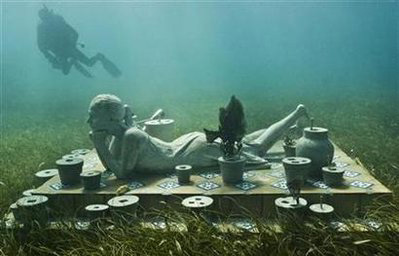
|  |  |  Travel & Outdoors Travel & Outdoors  
Fish, Divers Swim Through Underwater Mexico Museum
 Mica Rosenberg - Reuters Mica Rosenberg - Reuters
go to original
April 06, 2010


| | A diver swims near British artist Jason de Caires Taylor's sculpture "The Flower of Hope" in this undated handout in the Mexican resort of Cancun. At the bottom of its turquoise waters and playing with the reflections of the sun at sea, a series of sculptures were immersed in the Mexican resort of Cancun in what aspires to be a huge underwater museum that harmonizes with the beauty of its coral reefs. (Reuters/Jason de Caires Taylor) |  |
Cancun, Mexico – Schools of glittering silver-white fish swoop past a statue of a man hunched over a workbench, the first seabed artwork in a new underwater museum in Mexico's Caribbean Sea.

The cement sculpture, called "The Collector," shows a figure who records bottled treasures in logbooks. It weighs four tons and is anchored 26 feet under the sea. Divers watch a yellowtail damselfish nibble on algae growing from the sculpture's pant leg, which its creators hope will eventually sprout colorful coral.

About 400 life-size casts will be submerged off the resort of Cancun by the end of 2010. It is hoped that the low-acidity cement figures, designed to be anti-corrosive and mimic rock, will be transformed over time into artificial reefs. Some will be in shallow waters for snorkelers to enjoy.

"I wanted to make an impressive landscape where you can swim through a sea of faces," said Jason de Caires Taylor, the British artist behind the "Subaquatic Museum".

The aim is to lure some of the 800,000 tourists who visit Cancun's vast marine park each year - many during April's Easter week holiday - away from natural coral reefs battered by hurricanes, pollution and global warming.

Amateur divers can do even more damage to delicate undersea structures made by tiny animals called coral polyps if they are careless with their flippers, kicking up sand or knocking off coral that grows just a few centimeters a year.

"The park managers were looking for an alternative to manage the tourists. The idea was to concentrate everyone in one place," said de Caires Taylor, who has also built an underwater sculpture park in Grenada, West Indies.

The 400 figures, weighing 180 tons in total and to be named "Silent Evolution", will be submerged in a barren, flat expanse of the park, which lies between Cancun and nearby islands.

When coral starts to grow out of the figures it will create a magical image. But not everyone is convinced the works of art fit in a watery world.

"Some people like it but some say it has nothing to do with the natural surroundings and wonder why it's there," said Francisco Ruiz, who has been a diving instructor for 20 years.

Coral reefs, often called the rainforests of the ocean, are home to over a quarter of the world's marine life, even though they cover less than one percent of the ocean floor.

But scientists say nearly 30 percent of the colorful reefs that look like rocky gardens have already been lost and another two-thirds around the world are under serious threat.

On Cancun's man-made shoreline a string of high-rise hotels and resorts popular with American "spring breakers" have led to a population boom, stressing the once pristine wilderness of the Yucatan peninsula. Some environmentalists see false reefs as a small way to protect the patches of coral that are left.

Over the years everything from New York City subway cars to old tires have been tethered to the ocean floor in the hope the scraps can become a home to fish. One company in Florida even offers to cast the ashes of cremated relatives into an artificial reef that will become a "living legacy."

But improperly managed artificial reefs can cause more harm than good, coming unhinged in storms and wreaking havoc on the ocean ecosystems, according to Roberto Iglesias, a reef expert at Mexico's National Autonomous University, or UNAM.

"If they are bowled over in a hurricane ... that would defeat the whole purpose," said Roy Taylor, de Caires Taylor's father and the model for "The Collector."

"So that's been his main concern, to make sure the structure is solid." |

 |
|  |



